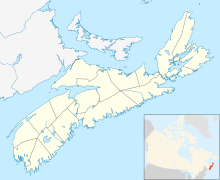Aspotogan Peninsula facts for kids
The Aspotogan Peninsula is a piece of land in Nova Scotia, Canada. It sticks out into the ocean. It's located in the eastern part of Lunenburg County.
This peninsula separates two large bays. To the east is St. Margarets Bay. To the west is Mahone Bay.
People from France first settled the east side. People from Germany settled the west side. Fishing was a very important job for people living here. Farming and forestry were also important. Later, shipping and shipbuilding became big industries.
Contents
Communities on the Peninsula
The Aspotogan Peninsula has many small towns and villages along its coast. These communities are often focused on fishing or tourism. Hubbards is the largest community. It's in the northeast part of the peninsula.
Other communities around the peninsula include:
- Fox Point
- Mill Cove
- Birchy Head
- The Lodge
- Northwest Cove
- Southwest Cove
- Aspotogan
- Bayswater
- New Harbour
- Blandford
- Upper Blandford
- Deep Cove
- East River
Route 329 is a road that goes around the coast of the peninsula. Other main roads like Trunk 3 and Highway 103 pass by to the north.
History of Aspotogan
The name Aspotogan comes from an old word. It means "block the passageway" or "where the seals go in and out." The land here is very high. Sailors used it as a landmark when coming from Europe.
Early Settlers
The first people to live on the Aspotogan Peninsula were the Mi'kmaq. Later, different groups of immigrants arrived. These included people from Newfoundland, New England, and other parts of Europe.
The Mi'kmaq People
The Mi'kmaq were the first people to live on the Aspotogan. They were a nomadic people. This means they moved around with the seasons. They lived along the Atlantic coast in the summer. In winter, they moved inland to the lakes. Mi'kmaq sites have been found in places like Fox Point and Northwest Cove. They lived on the Aspotogan until around World War II.
Newfoundland Immigrants
Some of the first European settlers were from Newfoundland. They arrived in the 1750s. By 1767, about 22 people from Newfoundland lived on the peninsula. Most of them did not stay long. Only a few family names like Murphy, Keating, and Carroll remain today. Some places are named after these early settlers. Examples include Riley Point and Hollahan Lake.
New England Planters
Another group of settlers came from New England. They were called "Planters." Many came from Massachusetts in the 1760s. They first settled in a town called Chester. Some of them then crossed Mahone Bay to live on the Aspotogan Peninsula. By 1767, eleven Americans were living there. It's also believed that some English people settled here.
Foreign Protestants
After 1767, many "Foreign Protestants" came to the Aspotogan. These were people from different parts of Europe. They spoke German and French. Many of them first settled in Lunenburg, Nova Scotia.
In 1782, Lunenburg was attacked. After this, many German and French-speaking people moved away. Some German speakers went to Rose Bay. French speakers started French Village, Nova Scotia. The west side of the Aspotogan Peninsula was settled by Germans. The east side was settled by the French.
Tourism and Fun
Tourism became popular in the 1800s. Hubbards was a regular stop for stagecoaches. In 1905, a railway was built. It connected Halifax to Yarmouth. This made it easy for visitors to reach the beautiful beaches and scenery. Many hotels and cottages were built.
Later, in 1969, Highway 103 was finished. This highway made it much faster to drive to Halifax. It only took about 45 minutes. This encouraged more people to live on the peninsula and work in Halifax. The land prices were good, and people liked the rural setting.
Today, tourism is still very important. People from all over the world visit. Bed and breakfasts, inns, restaurants, and campgrounds are busy in the summer. The Shore Club is a famous place. It's known for its Saturday night dances and delicious lobster suppers.
There was a plan to build a big luxury hotel called the Aspotogan Sea Spa. Construction stopped in the 1990s because of money problems. The large, unfinished hotel sat empty for twenty years. It was finally torn down in 2016.
Military Presence
The Aspotogan Peninsula has some military history.
During World War I, a tall look-off tower was built on Aspotogan mountain. It was used to watch for ships.
In 1944, a hotel called The Gainsborough was bought by the government. It became part of a training school for the Canadian Merchant Navy. Later, a library was built on this site.
In 1967, Canadian Forces Station Mill Cove opened. This was a naval radio station. It covered a large area of land. It was a big employer for the local community. The station was automated in the late 1990s.
Film, TV, and Books
The Aspotogan Peninsula has been a setting for movies, TV shows, and books.
In 1994, a group called the Aspotogan Heritage Trust was formed. They took over the old buildings at CFS Mill Cove. They created Mill Cove Park. This park includes the province's first dedicated sound stage. Many films and TV shows have been made here. These include the CBC Television series Black Harbour and Blackfly.
The Hollywood movie High Tide at Noon (1957) was filmed in Northwest Cove, Nova Scotia. The movie The Shipping News, starring Kevin Spacey, was filmed in Blandford.
Author Frank Parker Day lived on East Ironbound. This is an island near Blandford, Nova Scotia. His famous novel Rockbound was based on his experiences there.
The movie Deeply, starring Kirsten Dunst, was also filmed on East Ironbound.
See Also


